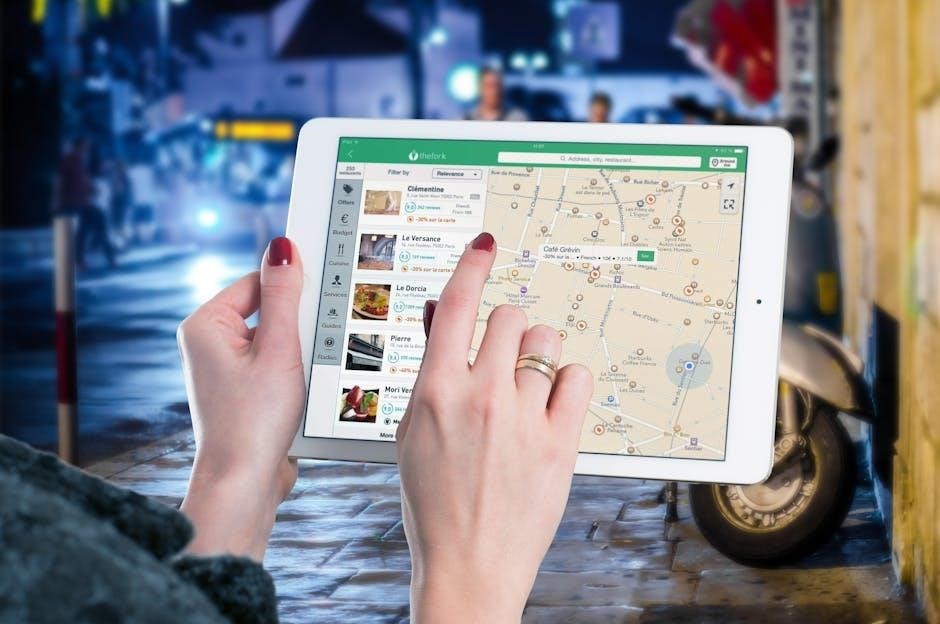Concord 4 Security System: User Guide Article Plan
This article provides a comprehensive guide to the Concord 4 security system. It covers everything from system components and arming/disarming procedures to troubleshooting and maintenance. Whether you’re a new user or looking to enhance your understanding‚ this guide will prove invaluable for optimal system utilization and security.
The Concord 4 security system is a robust and versatile solution designed to protect your home or business. This user guide provides a comprehensive overview of the system‚ its features‚ and how to effectively use it to safeguard your property and loved ones. The Concord 4 is more than just an alarm system; it’s a complete security solution that integrates various components to provide a comprehensive safety net.
This section will introduce you to the Concord 4 system‚ highlighting its key features and benefits. Understanding the basics of the Concord 4 is crucial for maximizing its potential and ensuring your peace of mind. We will explore the system’s capabilities‚ including its ability to detect burglaries‚ fires‚ and medical emergencies. This guide will also delve into the various ways you can interact with the system‚ such as through touchpads‚ mobile devices‚ and professional monitoring services.
Whether you’re a new user or an experienced one‚ this introduction will provide valuable insights into the Concord 4 system and how it can help you create a safer and more secure environment. Let’s begin exploring the world of Concord 4 and unlock its full potential to protect what matters most.
System Components Overview
The Concord 4 security system comprises several key components working in unison to provide comprehensive protection. Understanding each component’s role is essential for effective system operation and troubleshooting. At the heart of the system lies the main control panel‚ typically housed in a secure‚ out-of-sight location. This panel serves as the central processing unit‚ receiving signals from various sensors and devices and initiating appropriate responses.
Touchpads provide a user interface for arming and disarming the system‚ viewing system status‚ and accessing other functions. Door and window sensors detect unauthorized entry‚ triggering an alarm when a protected point is breached. Motion detectors monitor interior spaces‚ detecting movement and alerting the system to potential intrusions. Smoke and heat detectors provide early warning of fire hazards‚ allowing for prompt evacuation and response.
Optional components‚ such as glass break detectors‚ carbon monoxide detectors‚ and flood sensors‚ can further enhance the system’s capabilities. Wireless key fobs offer convenient remote arming and disarming‚ while cellular communication modules ensure reliable alarm transmission even during power outages or phone line disruptions. This overview will provide you with a detailed understanding of each component‚ ensuring you grasp how they contribute to your overall security.
Arming and Disarming the System

Effectively arming and disarming your Concord 4 security system is crucial for maintaining a secure environment. Arming the system activates the various sensors and detectors‚ providing protection against intrusion‚ fire‚ and other emergencies. Disarming the system deactivates these sensors‚ allowing you to move freely within your property without triggering an alarm.
To arm the system‚ typically you will use the touchpad. Input your unique four-digit code‚ followed by the “Arm” command. There are usually different arming modes‚ such as “Stay” (arming perimeter sensors while allowing interior movement) and “Away” (arming all sensors). Choose the appropriate mode based on your needs. The touchpad will confirm the arming status with an audible beep and a visual indicator.
Disarming the system is equally straightforward. Upon entering your property‚ immediately proceed to the touchpad and enter your code‚ followed by the “Disarm” command. Failure to disarm the system promptly will result in an alarm activation. Familiarize yourself with the specific arming and disarming procedures outlined in your user manual to ensure seamless operation. Regularly practice these steps to build confidence and prevent accidental alarms.
Understanding Alarm Types (Burglary‚ Fire‚ Medical)

The Concord 4 security system is designed to protect you from various threats‚ and it distinguishes between different types of alarms to ensure an appropriate response. Understanding these alarm types – burglary‚ fire‚ and medical – is essential for effective system operation and personal safety.
A burglary alarm is triggered when unauthorized entry is detected‚ typically through door or window sensors. Upon activation‚ the system sounds an audible alarm and transmits a signal to the monitoring center. The monitoring center will then attempt to verify the alarm and dispatch the appropriate authorities.
A fire alarm is triggered by smoke or heat detectors. It’s crucial to respond quickly to a fire alarm‚ evacuating all occupants from the building and notifying the fire department. Some systems also allow for manual fire alarms to be activated by pressing dedicated buttons on the touchpad.
A medical alarm is activated manually‚ usually by pressing a panic button on the touchpad or a wearable pendant. This type of alarm is used to signal a medical emergency‚ such as a fall or sudden illness. The monitoring center will respond by attempting to contact you and dispatching medical assistance if necessary.
Responding to Alarms
Knowing how to respond effectively to an alarm triggered by your Concord 4 system is crucial for ensuring your safety and minimizing potential damage. The appropriate response will vary depending on the type of alarm and the specific circumstances.
Burglary Alarm: If you are present when a burglary alarm sounds‚ immediately evacuate the premises if it is safe to do so. Contact the authorities from a safe location and provide them with any relevant information. If you are unsure about the cause of the alarm‚ you can attempt to disarm the system using your code. However‚ exercise caution and be aware of your surroundings.
Fire Alarm: Upon hearing a fire alarm‚ evacuate the building immediately. Do not attempt to gather belongings or investigate the source of the fire. Once you are safely outside‚ call the fire department and provide them with your location and any details about the fire.
Medical Alarm: If you have activated a medical alarm‚ remain calm and wait for assistance. The monitoring center will attempt to contact you to verify the alarm and dispatch medical personnel if necessary. If you are able‚ provide the monitoring center with any relevant medical information.
Touchpad Operation
The touchpad is the primary interface for interacting with your Concord 4 security system. Understanding its functions and controls is essential for effective system management. The touchpad allows you to arm and disarm the system‚ view system status‚ bypass zones‚ and access other features.

Arming the System: To arm the system‚ press the “CMD” button until “ARM DISARM” displays. Then‚ select “ARM” (Key 1). Enter your four-digit alarm code. The system will arm in the selected mode (Away or Stay) after the exit delay.
Disarming the System: To disarm the system‚ enter your four-digit alarm code. The system will disarm‚ and the keypad will display the current system status.
Viewing System Status: The touchpad displays the current system status‚ including whether the system is armed or disarmed‚ any open zones‚ and any system troubles. Use the arrow keys to scroll through the available information.
Bypassing Zones: If a zone is malfunctioning or needs to be temporarily disabled‚ you can bypass it. Consult your user manual for specific instructions on bypassing zones using the touchpad.
Troubleshooting Common Issues
Even with a well-maintained system‚ occasional issues may arise. This section provides guidance on troubleshooting common problems encountered with the Concord 4 security system.
Problem: System beeping continuously.
Possible Cause: This usually indicates a system trouble‚ such as AC power loss or a low battery.
Solution: Check the AC power connection. If the system has a backup battery‚ ensure it is properly connected and charged. If the beeping persists‚ contact your monitoring service or a qualified technician.
Problem: False alarms.
Possible Cause: Common causes include faulty sensors‚ loose wiring‚ or environmental factors.
Solution: Inspect sensors for damage or obstructions. Ensure wiring connections are secure. Adjust sensor sensitivity if necessary. Consider consulting a technician for further evaluation.

Problem: System not arming.
Possible Cause: Open zones or system troubles may prevent arming.
Solution: Check the touchpad display for open zones. Secure any open doors or windows. Address any system troubles before attempting to arm the system.
Problem: Keypad not responding.
Possible Cause: Low battery or a loose connection.
Solution: Replace the keypad battery. Check the wiring connections between the keypad and the control panel.
RF Devices and Functionality
The Concord 4 system leverages Radio Frequency (RF) technology to wirelessly communicate with various devices‚ enhancing flexibility and ease of installation. Understanding the functionality of these RF devices is crucial for optimal system performance.
Types of RF Devices: The Concord 4 supports a range of RF devices‚ including door/window sensors‚ motion detectors‚ key fobs‚ and smoke detectors. These devices transmit signals to the control panel‚ enabling the system to detect intrusions‚ fire‚ or other emergencies.
Enrollment and Programming: Each RF device must be enrolled with the control panel before it can function properly. This involves entering the device’s unique identification code into the system programming. Refer to the installation manual for detailed enrollment instructions.
Signal Strength and Range: The performance of RF devices depends on signal strength and range. Obstructions‚ such as walls and metal objects‚ can weaken the signal. Test the signal strength of each device after installation to ensure reliable communication. Consider using repeaters to extend the range if necessary.
Battery Life: RF devices are battery-powered‚ and battery life varies depending on usage and environmental factors. Regularly check the battery status of each device and replace batteries as needed to maintain system reliability.
Installation Guide Overview
This section provides a simplified overview of the Concord 4 installation process. While professional installation is recommended‚ understanding the basics can be beneficial. Always consult the complete installation manual for detailed instructions and safety precautions.
Planning: Before starting‚ carefully plan the placement of all system components‚ including the control panel‚ sensors‚ and keypad(s). Consider factors such as coverage area‚ accessibility‚ and power availability. Document your plan using the provided planning sheets.
Wiring: The Concord 4 requires wiring for power‚ telephone line connection (if applicable)‚ and some hardwired sensors. Ensure all wiring is done correctly and securely. Follow local electrical codes and regulations.
Panel Mounting: Mount the control panel in a secure‚ hidden location‚ away from potential damage. The steel cabinet should be properly grounded. Ensure easy access for maintenance and testing.
Sensor Installation: Install sensors according to the manufacturer’s instructions. Pay attention to proper alignment and secure mounting. For RF devices‚ ensure adequate signal strength.
Programming: The Concord 4 requires programming to configure system settings‚ define zones‚ and enroll devices. Use the keypad or programming software to enter the necessary information. Refer to the programming section of the installation manual.
Testing: After installation and programming‚ thoroughly test the system to ensure all components are functioning correctly. Verify alarm triggers‚ communication with the monitoring center (if applicable)‚ and keypad operation.
Maintenance and Testing
Regular maintenance and testing are crucial for ensuring the continued reliability and effectiveness of your Concord 4 security system. Neglecting these tasks can lead to system failures and compromise your security.
Battery Replacement: The Concord 4 relies on a backup battery to maintain operation during power outages. Replace the battery every 3-5 years‚ or as indicated by the system. Follow the manufacturer’s instructions for battery replacement.
Sensor Testing: Periodically test all sensors to verify their functionality. This includes door/window sensors‚ motion detectors‚ and smoke detectors. Trigger each sensor and ensure the system responds appropriately.
Communication Testing: If your system is monitored‚ regularly test the communication link with the monitoring center. This ensures that alarm signals are being properly transmitted. Contact your monitoring provider for testing procedures.
Visual Inspection: Conduct regular visual inspections of all system components‚ including the control panel‚ keypad‚ and sensors. Look for signs of damage‚ corrosion‚ or loose connections.
Cleaning: Keep the system components clean and free from dust and debris. Use a soft‚ dry cloth to wipe down the keypad and sensors.
Professional Inspection: Consider scheduling a professional inspection of your system every few years. A qualified technician can identify potential problems and perform necessary maintenance.
Log Maintenance: Keep a record of all maintenance and testing activities‚ including dates‚ results‚ and any actions taken. This will help you track the system’s performance and identify any recurring issues.
Contacting Support and Monitoring Services
Having reliable support and monitoring services is essential for maximizing the benefits of your Concord 4 security system. Whether you have technical questions‚ need assistance with troubleshooting‚ or require emergency response‚ knowing how to access these resources is crucial.
Technical Support: For technical issues or questions regarding the system’s operation‚ consult the Concord 4 user manual or visit the manufacturer’s website. Many manufacturers offer online resources‚ FAQs‚ and troubleshooting guides. If you cannot find the answer you need‚ contact their technical support team directly via phone or email.
Monitoring Services: If your system is professionally monitored‚ you should have a dedicated phone number to contact the monitoring center. Keep this number readily accessible in case of emergencies. Familiarize yourself with the monitoring company’s procedures for reporting alarms and requesting assistance.
Local Security Professionals: Consider contacting a local security company that specializes in Concord 4 systems. They can provide installation‚ maintenance‚ and repair services. They can also offer customized security solutions tailored to your specific needs.
Emergency Services: In the event of a burglary‚ fire‚ or medical emergency‚ contact the appropriate emergency services (police‚ fire department‚ ambulance) immediately. Do not rely solely on the security system to alert emergency personnel.
Documentation: Keep all relevant documentation‚ including the user manual‚ warranty information‚ and contact information for the manufacturer‚ monitoring company‚ and local security professionals‚ in a safe and easily accessible location.
